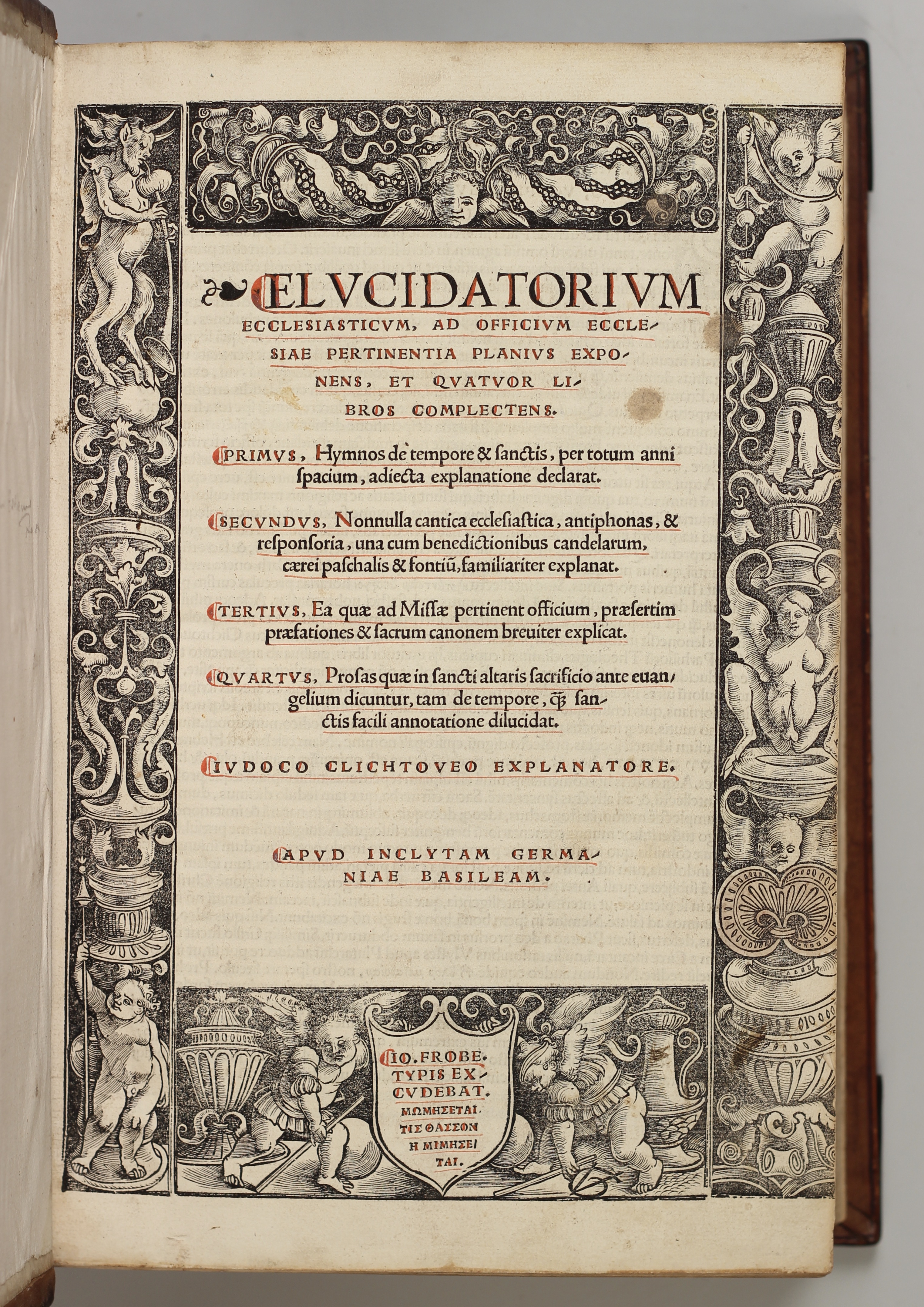Clichtove / Dionysius Areopagita / Johannes Damascenus [sold]
Sammelband — Paris 1512, 1515 / Basel 1517
Clichthoveus, Judocus
Elucidatorium ecclesiasticum, ad officium ecclesiae pertinentia planius exponens, et quatuor libros complectens […]. – [Colophon:] Basilea apud Io. Frobenium mense Augusti an. M. D. XVII. [Basel, J. Froben, 1517]
Dionysius Areopagita
Coelestis hierarchia. Ecclesiastica hierarchia. Divina nomina. Mystica theologia. – [Colophon:] In alma Parisiorum academia per Henricum Stephanum artis formulariae peritum et sedulum opificem. e regione Scholae Decretorum habitantem. Anno ab incarnatione eiusdem domini nostrum Ihesu Christi. 1515. die vero mensis Aprilis decima quarta. [Paris, H. Stephanus, 14th April 1515]
Johannes Damascenus
Theologia quatuor libris explicata: et adiecto ad litteram commentario elucidata. – Haec Damasceni cum expositione prima aemissio typis absoluta est Parisijs: ex officina Henrici Stephani e regione Scholae Decretorum. Anno Christi omnim conditoris et rectoris. M. D. XII. Nonis Februaris. [Paris, H. Stephanus, 5th Febr. 1512]
Folio (306 x 196 mm). Rubricated throughout. Dionysius and Damascenus with many deckle edges.
Binding: Contemporary blindstamped calf over thick wooden boards, rebacked preserving orginal spine. Six of eight metal corner-pieces remain, clasps gone. Inner blank margin of the last leaves with a few tiny wormholes.
Four conjugates leaves from a 13th-century breviary manuscript on vellum as rear pastedowns.
A contemporary Cologne binding of the I. V. B. bindery: Einbanddatenbank (online: hist-einband.de) w002798, which is the number of the bindery, and r001434, which is the number of the role.
Provenance: 1. The title-page of the Johannes Damascenus shows at its bottom a painted shield with the initials J R. The Dionysius title-page has this shield also but without initials. 2. Library of the Dukes of Arenberg, Nordkirchen.
A most beautiful copy.
Clichthove:
a-z, A-P6 Q8: (6), 229, (1) leaves. Woodcut title-border by Urs Graf. Last leaf with Froben’s mark. Title-border slightly touched in outer margin. – VD16, C 4193; Adams C-2201.
Dionysius Areopagita:
a-z, A-E8: 224 leaves. Woodcut title-border. This title-border (Silvestre 1066) Estienne took over from his former partner Wolfgang Hopyl; in Estienne’s own books it appears quite rarely.- Renouard p. 16, no. 3; Adams D-523.
Johannes Damascenus:
a-z, A,B8 C4 (-C4): 203 leaves, lacking last blank. Woodcut title-border (Silvestre 906). – Renouard p. 11, no. 3; Adams J-278; Mortimer II, 329.
¶ Josse Clichthove (1472-1543) from Nieuwpoort in Flanders, studied in Leuven and Paris, pupil of Lefèvre d’Etaples/Faber Stapulensis, whose editions of Aristotle he annotated; with Briçonnet, to whom the Dionysius is dedicated, and Lefèvre, he was one of the leading figures of the French reform movement until 1520; after that he concentrated almost exclusively on the debate with Luther. The Elucidatorium was first published by Estienne in Paris in 1516. Wolfgang Capito, a member of the humanist circle in Basel, urged Froben to print and publish the book, which must have met with great interest. The dedicatory letter is addressed by Capito to the Bishop of Basel, Christoph von Utenheim, whose efforts and open-mindedness attracted numerous humanists to Basel (cf. Bietenholz III, 361 ff.). The work proved very successful, further editions were published in 1519 (Basle), 1520 (2nd Estienne ed.), and in Paris 1540, 1548, 1556, 1558, 1821.
Ps.-Dionysius:
First edition published by Henri Estienne. Lefèvre d’Etaples‘ „Scholia Stapulensis“ and Clichthove’s commentary follow the ps.-Dionysius. On the corpus of ps.-Dionysius‘ texts Ernst Cassirer wrote: „Medieval cosmology and medieval faith, the view of the world order and that of the moral-religious order of salvation merge here into a single fundamental view, into an image of the highest conciseness and the highest inner consistency.“ (Individuum u. Kosmos in der Philos. der Reniassance).
Johannes Damascenus:
First pubished by Estienne in 1507; the present edition is the first of Faber’s translation with Clichthove’s extensive commentary, which is printed in a smaller type. On f. 44f. is a table of the Zodiac for the year 1507. Clichthove added not only his commentary but also chapter numbering to text and commentary in the inner margin of the leaves to find easily to which passage the comment refers to. He also added a great number of references printed as marginalia.
„Under the title of Theologia Lefèvre has translated John of Damascus‘ De orthodoxa fide, which is his most important work. Lefèvre undertook the translation in response to Erasmus‘ demand that, in order to counteract scholasticism the works of the early Church Fathers must be made accessible to the public. Lefèvre, who translated relatively few Greek texts, chose this one evidently because he felt that it was one of the major works which had preserved and transmitted the Neoplatonic teaching of the Eastern Church on which Western mystical Christiane doctrine was built … The works contains John’s complete system of theology, founded on the teaching of the Fathers and Church Councils, and embodies the final formulation of the theological thought of the early Greek Church. Included in John’s theological system are also many interesting scientific observations, e. g.: an astronomical and astrological discussion, with a description of heavenly bodies, their motions, and other natural phenomena …“ (Schreiber, The Estiennes, no. 6, i. e. the 1507 ed.).














